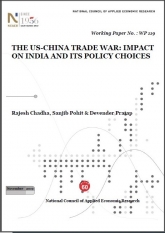The US-China Trade War Impact on India and its Policy Choices
Sanjib Pohit
Devender Pratap
Rajesh Chadha
November 2019
he five-year period 2012-13 to 2016-17 witnessed a decline in Indian merchandise exports at an average rate of 4.5 percent per annum. The Ministry of Commerce and Industry initiated a discussion in August 2018 on designing a strategy for doubling India’s exports by 2025. This growth from US$ 504 billion exports of goods and services in 2017-18 to above US$ 1,000 billion in 2025-26 would imply an underlying growth rate of exports of above 9 percent per annum. While merchandise exports constitute close to 63 percent of total exports, the share of service exports has been 37 percent during the last three years, 2015-16 to 2017-18. Assuming these proportions remain unchanged, a doubling of merchandise exports in six years would mean going from the base 2017-18 level of US$ 309 billion to about US$ 618 billion by 2025-26, and service exports going from US$ 195 billion to US$ 390 billion. These are challenging targets. They raise the question of whether there are unexplored strategic opportunities in the current global trade situation, including in the looming US-China trade war, which can help India either achieve these targets or at least ensure that there are no significant reversals on the path to achieving them. This NCAER paper reflects on how India should react to the trade tensions between the world’s two largest economies.
National Growth and Macroeconomic Centre







